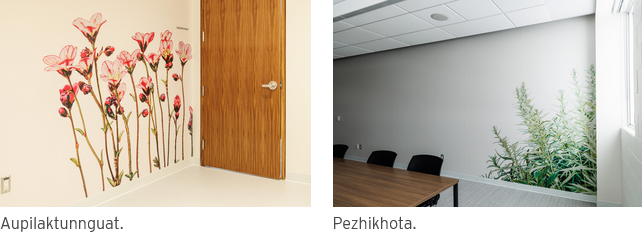When you step into RRC Polytech's Interdisciplinary Health and Community Services Simulation Centre (the Simulation Centre), surrounded by sleek equipment and cutting-edge technology, you might be surprised by something soft, vibrant, and unexpected: drawings of traditional Indigenous Medicines that seem to bloom right out of the walls.
Sweetgrass curls in the corner, sage branches in pale greens and silvers, and Labrador tea in buds and bloom beckon from the end of the hall. Nine large-scale plant drawings are installed in different places around the Simulation Centre, reminding students, staff, and visitors that traditional Medicine is the foundation of today's medical technology.
Christine Kirouac, the local artist behind the illustrations, says that the creative process for designing the drawings required a lot of patience and many conversations with different people, including with the Knowledge Keepers Council at RRC Polytech. The Knowledge Keepers provided direction on the spiritual and cultural significances of the selected Medicines and the names that described each plant in the different Indigenous languages to which they're referred.
"I spoke with Elders, gardeners - whom I know have a wealth of knowledge about plants and Medicines - and builders to understand how the illustrations would appear within the architecture," said Kirouac. "So, the question became: how do we move these together?"
The Simulation Centre project team envisioned a dynamic health environment that celebrates the latest advancements of modern medicine while honouring the roots of traditional Indigenous Medicines, which have shaped countless contemporary medical practices and remedies.

They selected Kirouac, a Métis interdisciplinary artist, to craft striking illustrations that breathed life into this vision. Infusing the space with cultural and visual resonance, Kirouac's drawings vividly depict a curated selection of sacred Medicines - wiingwashk, maskawáhtik, pezhikhota, aupilaktunnguat, ahsehsap, and nagothe - each chosen to weave a powerful reminder of healing and heritage.
The project began in the deep cold of January - too early in the season to find the plants growing in the prairie landscape, so she turned to photographs that showed the plants in various stages, some up close, some from afar.
She took care with every creative decision. Each illustration was created with its final placement in mind. Pezhikhota - sage in Dakota - and wiingashk - sweetgrass in Anishinaabemowin - nestle into the corners of the rooms, as if they're creeping in from outside. Aupilaktunnguat - or saxifrage in Inuktitut - is the floral emblem of Nunavut, and the drawing bursts with colour in the Quiet Room.
This tension between the clinical and the natural is exactly the point. Kirouac says the drawings don't feel like decoration. She intended for them to be in conversation with the function of the space - a bridge between traditional knowledge and Western medicine.
"There's often this assumption that these worlds are at odds - like it's either one or the other," she says. "But it doesn't have to be a trade-off. We can integrate. We can let them speak to each other."
By highlighting focused, close-up views on broad canvases, the drawings invite deeper engagement with the complexity and nuance of natural forms in contrast with the manufactured equipment and medications with which students train in this environment.
This approach reveals the richness found in these Medicines. What might seem like a single shade of green at first glance turns out to be a complex mix of hues, each influenced by subtle differences in light, shadow, and timing.
"Take the cedar for example - some parts are really dark, and that's because the reference image was taken at midday. The shadows are very sharp. Those shadows suggest an environment with a specific weather, climate, and time of day," said Kirouac.
Other works, like her renderings of sage and sweetgrass, are filled with light. The angled shards of green framed with slashes of darkness capture the plants in an afternoon light on a sunny day.
Her compositions are intentional in both form and scale. The placements of the drawings, right up to the edges or corners, are designed into each original piece. This meticulous attention to detail, light, and structure evokes a distinct sense of place and moment in time, capturing the living essence of the plants Kirouac portrays. Through her work, viewers are invited to slow down, look closer, and appreciate the layered beauty of the natural world.
"Once they were installed, I realized it was like the plants had found their way into this sterile space, reminding everyone of something older, something still alive."
Kirouac calls herself a shapeshifter - an interdisciplinary artist who listens to the subject matter, lets it guide her, and chooses her tools accordingly. In this case, painstakingly detailed graphite drawings became the medium to explore the place of Indigenous Medicines in a Western clinical environment.

Christine Kirouac and nagothe.
Visitors will have the opportunity to admire the original 32" x 40" drawings themselves once they are installed in the Library at Notre Dame Campus even when the Simulation Centre is in use.
When you see the illustrations, you might not know the whole story - but maybe you'll recognize a leaf, a stem, a shadow, and maybe that's enough to start your own connection.
Medicines in the Simulation Centre

Artist's Statement
Kirouac is a Winnipeg, MB-born interdisciplinary artist, who draws. Draws on experience, draws on personal stories, draws on surroundings and circumstances, then draws on paper. Unlike her other projects requiring engagement with outside technical expertise, collaborators and materials, Kirouac's long-term relationships with her drawn subjects require herself alone, her materials, and her investment of real time. This deep connection to form, light and texture (without context in some cases) and time spent is on clear display.
Kirouac is Métis and hermetic practices are natural to her biological people, but as an adoptee brought up around different formal structures of home and family, her struggle to secure her place has persisted since her first childhood recollection. Her rituals of walking in both urban and wild settings, recording then intensively drawing allows her to reconsider her pining to belong through the lens of organic elements and their inherent acceptance of constant rhythms of change and ultimate and ironic disappearance. Forms become figures and environments become sets into which she and the viewer can project themselves. Her quest has manifested differently throughout her career but her willingness to commit to drawing specifically became an act of preservation not only a memory of place, but of herself. Over time, she becomes encrypted with the moment she invests in and the drawn results house her.












